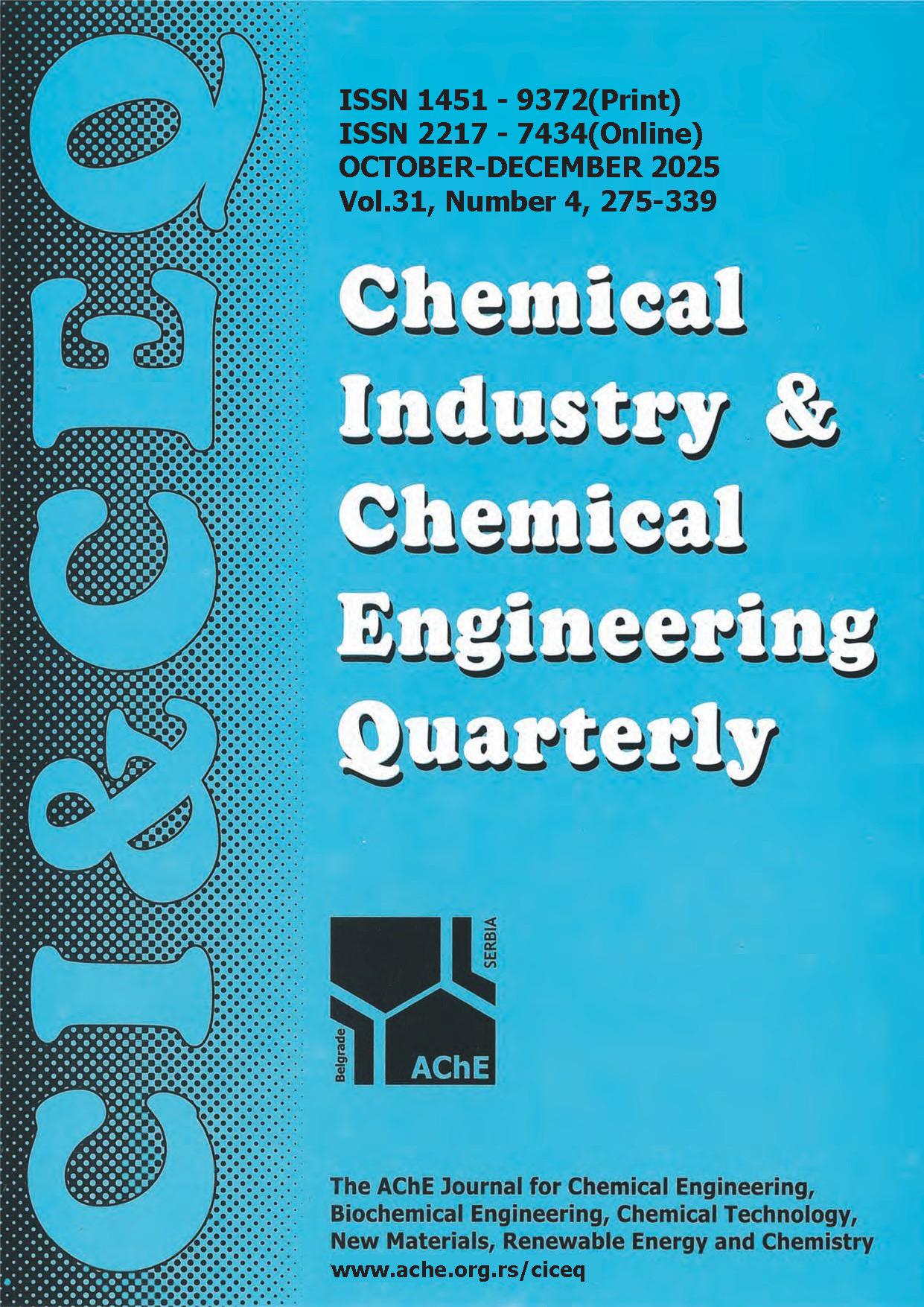FORECASTING RESEARCH OF MIXING UNIFORMITY OF CERIUM CHLORIDE SOLUTION UNDER MICROWAVE HEATING
Original scientific paper
DOI:
https://doi.org/10.2298/CICEQ240712002LKeywords:
Cerium oxide, physical experiment, numerical simulation, VMD-SSA-LSTM, forecastAbstract
Cerium oxide is an important strategic resource and a key raw material for many functional materials in high-tech fields. Microwave heating is an important method to prepare cerium oxide. In the study of cerium oxide prepared by microwave heating, the variation of the polarity factor inside the solution during heating was explored. In addition to thermal effects, microwave heating also exerts electromagnetic influences that promote the mixing of the solution. This study presents both physical experiments and numerical simulations of the mixing behavior of cerium chloride solutions under microwave exposure. The results reveal that under the influence of the microwave electromagnetic field, the mixing uniformity of the solution remains consistent and stable across the entire region. The VMD-SSA-LSTM model was proposed to forecast the mixing uniformity under different process conditions. The results show that the mixing effect of cerium chloride solution under microwave is better than that under conventional heating. The selected forecast model saves time and energy and can accurately forecast the above situation. In addition, the forecast effect is best when the modal number k of VMD decomposition is selected as 3.
References
[1] C.Y. Chen, J.M. Lu, Q.Z. Yao, Chem. Eng. Sci. 22 (2016) 2501—2512. https://doi.org/10.12659/MSM.899852.
[2] Y. Xu, S.H. Yang, G.X. You, Asian J. Ecotoxicol. 16 (2021) 43—55. https://kns.cnki.net/kcms2/article/abstract.
[3] A. Patlán, V. Ayala-García, L. Valenzuela-García, PLoS. One. 14 (2019) e0211653. https://doi.org/10.1371/journal.pone.0211653.
[4] P. Min, S.Z. Zhang, Y.H. Xu, R.X. Li, Appl. Surf. Sci. 448 (2018) 435—443. https://doi.org/10.1016/j.apsusc.2018.04.103.
[5] G. Yoganandan, V. Durgambika, P. Manoj, M.N. Thayee, B.J. Nagabushan, R. Michael, N. Lakshman, Electrochim. Acta. 425 (2022) 140696. https://doi.org/10.1016/j.electacta.2022.140696.
[6] B. Richa, N. Sreeja, K. Krishna, Mater. Today Commun. 30 (2022) 103177. https://doi.org/10.1016/j.mtcomm.2022.103177.
[7] D.T. Diksha, M. Ananthkumar, Mater. Today: Proc. 49 (2022) 2007—2012. https://doi.org/10.1016/j.matpr.2021.08.1572.
[8] N. Li, Z.D. Chen, J.J. Wang, J. Mater. Rev. 36 (2022) 54—63. https://kns.cnki.net/kcms2/article/abstract.
[9] C.Y. Wang, P. Tong, C. Li, Carcinog., Teratog. Mutagen. 31 (2019) 464—468. https://kns.cnki.net/kcms2/article/abstract.
[10] L. Zhang, L.M. Zhu, T. Zhou, P. Guo, X. Wang, P. Liu, W. Shao, Mater. Des. 215 (2022) 110451. https://doi.org/10.1016/j.matdes.2022.110451.
[11] T. Bhusankar, Y. Kisoo, K. Jonghoon, Ceram. Int. 48 (2022) 3628—3635. https://doi.org/10.1016/j.ceramint.2021.10.143.
[12] H. Yang, L. Jia, Z. Zhang, B. Xu, Z. Liu, Q. Zhang, Y. Cao, M. Zhang, T. Ohno, J. Catal. 405 (2022) 74—83. https://doi.org/10.1016/j.jcat.2021.11.017.
[13] S. Galema, Chem. Soc. Rev. 26 (1997) 233—238. https://doi.org/10.1039/CS9972600233.
[14] C.O. Kappe, Chem. Bio. Chem. 43 (2004) 6250—6284. https://doi.org/10.1002/anie.200400655 .
[15] B.A. Roberts, C.R. Strauss, Acc. Chem. Res. 38 (2005) 653—661. https://doi.org/10.1021/ar040278m.
[16] F. Wiesbrock, R. Hoogenboom, U.S. Schubert, Macromol. Rapid Commun, 25 (2004) 1739—1764. https://doi.org/10.1002/marc.200400313.
[17] J.A Gerbec, D. Magana, A. Washington, G.F Strouse, J. Am. Chem. Soc. 127 (2005) 15791—15800. https://doi.org/10.1021/ja052463g.
[18] C. Lv, X. Lv, Q.Y. Zhao, Rare Metal. 46 (2022) 394—401. https://doi.org/10.13373/j.cnki.cjrm.xy19070035.
[19] C. Lv, T.A. Zhang, Z.H. Dou, Q.Y. Zhao, Rare Metals. 38 (2019) 1160—1168. https://doi.org/10.1007/s12598-019-01337-9.
[20] C. Lv, H.X. Yin, Y.L. Liu, X.X, Chen, H.L. Zhao, JOM. 75 (2023) 2421—2429. https://doi.org/10.1007/S11837-022-05654-W.
[21] C. Lv, T.A. Zhang, Z.H. Dou, Q.Y. Zhao, JOM. 71 (2019) 34—39. https://doi.org/10.1007/s11837-018-3194-4.
[22] C. Luan, Water Resources & Hydropower of Northeast China. 42 (2024) 23—29. https://kns.cnki.net/kcms2/article/abstract.
[23] Z.P. Lu, X.J Yu, C.Y. Lu, Journal of Wuhan University of Technology (Information & Management Engineering). 45 (2023) 546—551. https://kns.cnki.net/kcms2/article/abstract.
[24] H.J. Cao, Z.Y. Li, Modern Information Technology.8 (2024) 142—146152. https://doi.org/10.19850/j.cnki.2096-4706.2024.04.030.
[25] Y.J. Liu, Shandong University, 2024. https://kns.cnki.net/kcms2/article/abstract.
[26] S.Y. Pan, China University of Mining and Technology. 2023. https://kns.cnki.net/kcms2/article/abstract.
[27] J.L. Li, G.Y. Yin, G.H. Zhang, Proceedings of the 31st chinese control, 2012, 7552—7555. https://ieeexplore.ieee.org/abstract/document/6391279.
[28] Y.P. Ju, Y.G. Li, Chinese Automatomation Congress (CAC). 2017, 777—781. https://doi.org/10.1109/CAC.2017.8242871.
[29] M.T. Liu, B. Li, S. Yue, Y. Du, J. Xu, Signal image and video Pro. 18 (2024) 427—436. https://link.springer.com/article/10.1007/s11760-023-02738-1.
[30] Y.J. Zhang, W.N. Qin, X.F. Huang, HU BEI: CN104809297A, 2015-07-29. https://kns.cnki.net/kcms2/article/abstract.
[31] C. Lv, Y. Liu, G. Li, T. Yang, H. Zhao, X. Chen, Case Stud. Therm. Eng. 60 (2024) 104741. https://doi.org/10.1016/j.csite.2024.104741.
Downloads
Published
Issue
Section
License
Copyright (c) 2023 Chao Lv, Yanlong Liu, Lu Lu

This work is licensed under a Creative Commons Attribution-NonCommercial-NoDerivatives 4.0 International License.
Authors who publish with this journal agree to the following terms:
Authors retain copyright and grant the journal right of first publication with the work simultaneously licensed under a Creative Commons Attribution License that allows others to share the work with an acknowledgement of the work's authorship and initial publication in this journal.
Authors grant to the Publisher the following rights to the manuscript, including any supplemental material, and any parts, extracts or elements thereof:
- the right to reproduce and distribute the Manuscript in printed form, including print-on-demand;
- the right to produce prepublications, reprints, and special editions of the Manuscript;
- the right to translate the Manuscript into other languages;
- the right to reproduce the Manuscript using photomechanical or similar means including, but not limited to photocopy, and the right to distribute these reproductions;
- the right to reproduce and distribute the Manuscript electronically or optically on any and all data carriers or storage media – especially in machine readable/digitalized form on data carriers such as hard drive, CD-Rom, DVD, Blu-ray Disc (BD), Mini-Disk, data tape – and the right to reproduce and distribute the Article via these data carriers;
- the right to store the Manuscript in databases, including online databases, and the right of transmission of the Manuscript in all technical systems and modes;
- the right to make the Manuscript available to the public or to closed user groups on individual demand, for use on monitors or other readers (including e-books), and in printable form for the user, either via the internet, other online services, or via internal or external networks.




